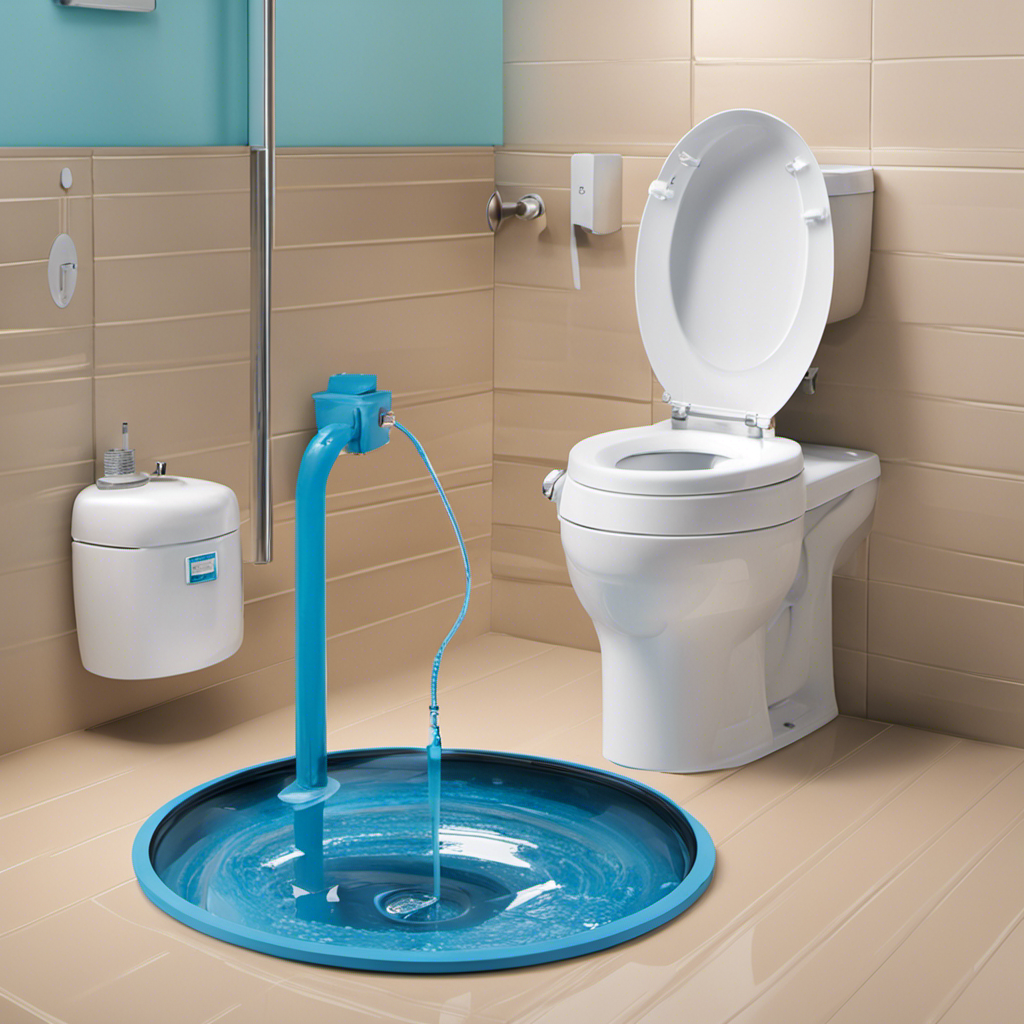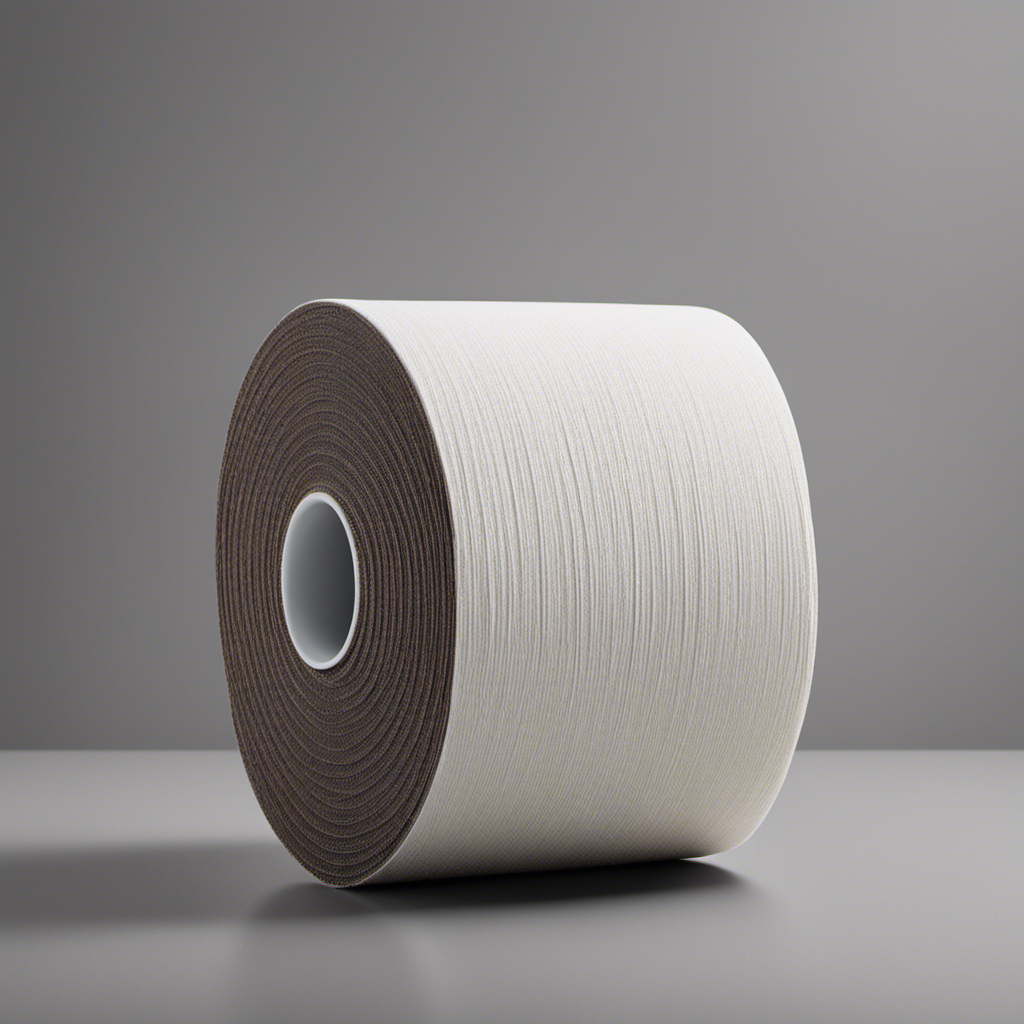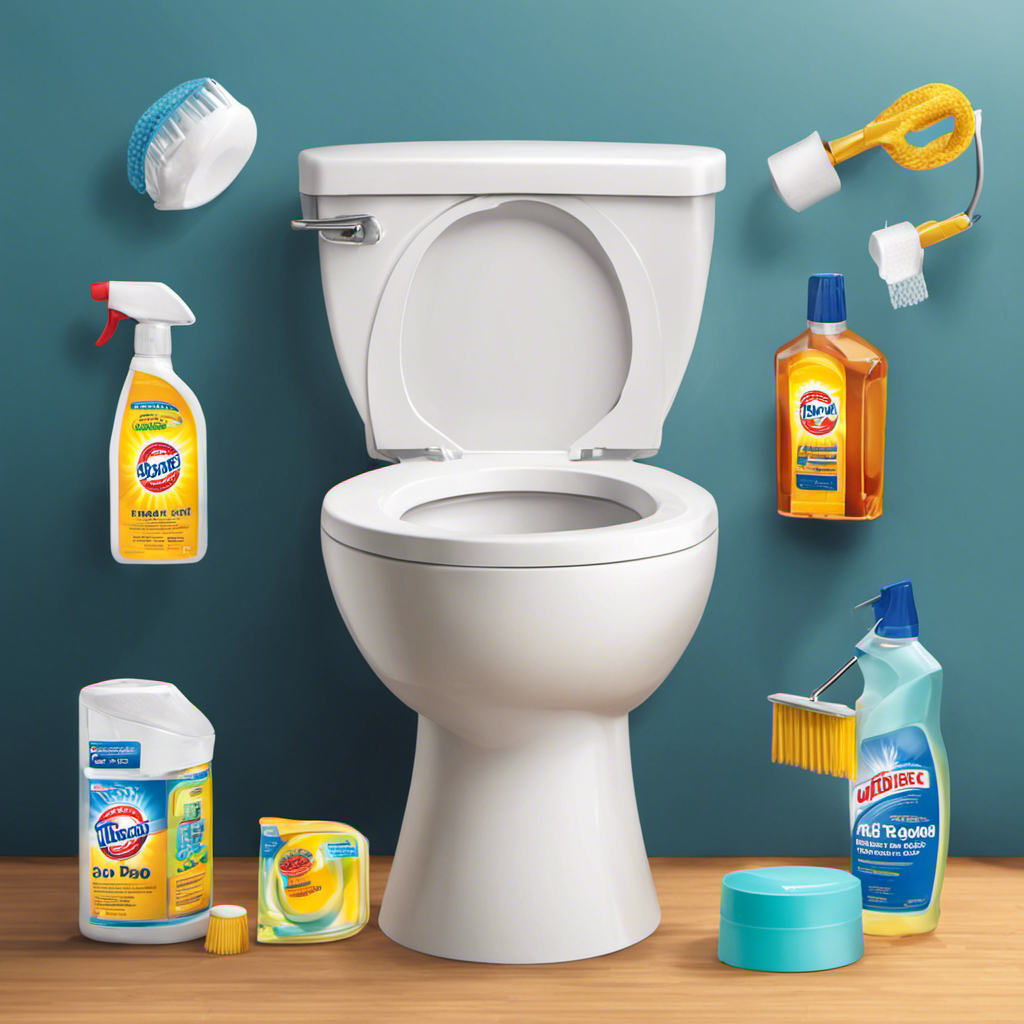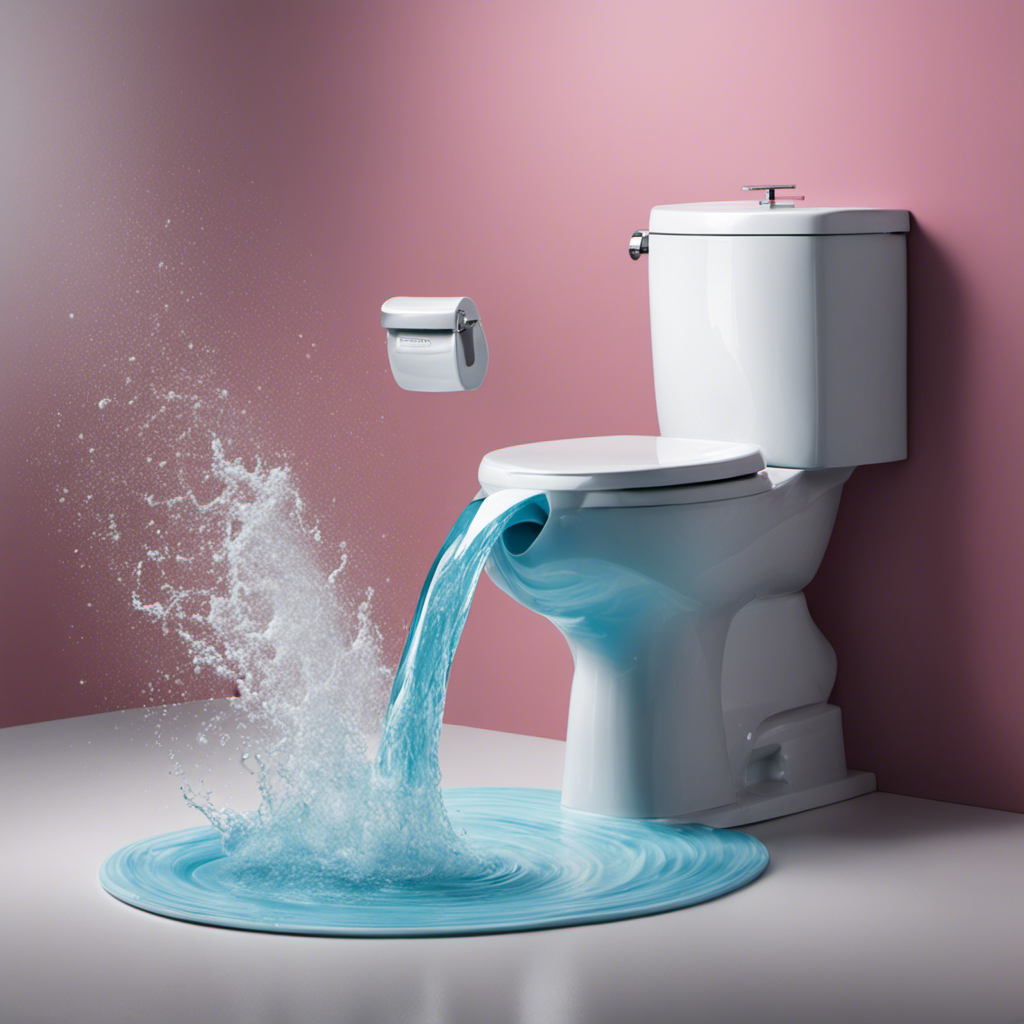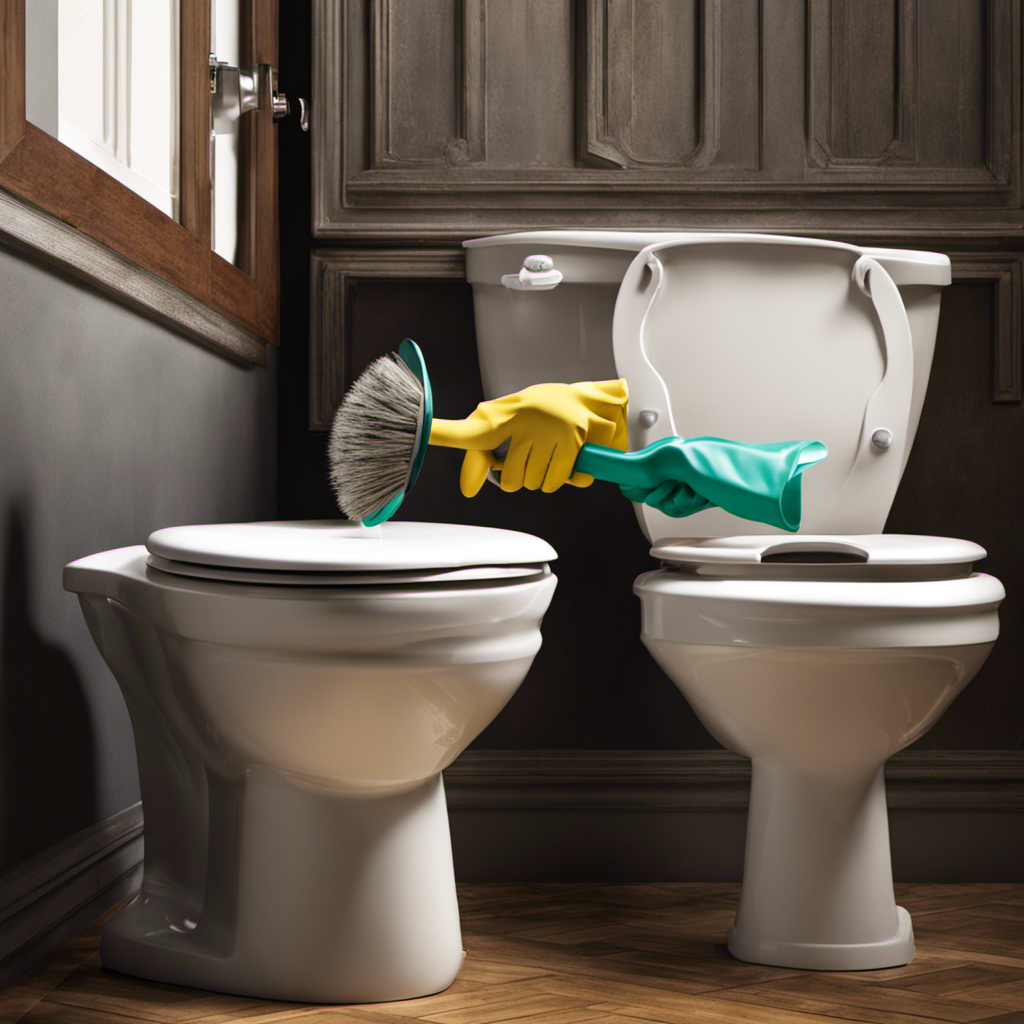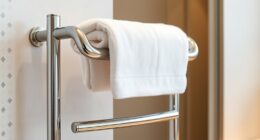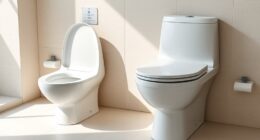As I tackle the issue of mold in my toilet, I’ve learned a few tricks that I’m excited to share. Mold can be a stubborn problem, but with the right supplies and a little elbow grease, it’s possible to eliminate it completely.
In this article, I’ll guide you through the process step by step, from understanding the mold problem to preventing future growth.
So let’s roll up our sleeves and get that toilet sparkling clean again!
Key Takeaways
- Mold in the toilet is caused by high humidity and moisture.
- Bleach or vinegar can be used to clean and remove mold stains.
- Proper ventilation and regular cleaning can help prevent future mold growth.
- It is important to wear gloves and a face mask when dealing with mold to protect yourself from spores.
Understanding the Mold Problem
To understand the mold problem in your toilet, you should know how it forms and thrives in damp environments. Mold is a type of fungus that grows in areas with high humidity and moisture. It reproduces by releasing spores into the air, which can easily spread and cause new mold colonies to form.
In the bathroom, the combination of moisture from showers and toilets provides an ideal breeding ground for mold. Not only is mold unsightly and can cause a musty odor, but it can also pose health risks. Breathing in mold spores can trigger allergies, asthma, and other respiratory issues.
To prevent mold growth in your toilet, make sure to keep the bathroom well-ventilated, fix any leaks or plumbing issues promptly, and regularly clean and dry the toilet area. By taking these mold prevention tips, you can ensure a healthy and mold-free bathroom.
Now that you understand the mold problem, let’s move on to gathering the necessary supplies for removing it.
Gathering the Necessary Supplies
You’ll need a few supplies to remove the mold from your toilet. Toilet mold prevention is important to maintain a clean and hygienic bathroom.
To effectively clean the mold, you will need gloves, a face mask, bleach or vinegar, a toilet brush, and a scrub brush.
Start by putting on the gloves and the face mask to protect yourself from the mold spores. Mix a solution of bleach or vinegar with water in a bucket.
Use the toilet brush to flush the toilet and remove any excess water. Then, apply the bleach or vinegar solution to the affected areas and let it sit for a few minutes.
Scrub the mold away using the scrub brush, making sure to reach all the crevices. Rinse the toilet thoroughly and repeat the process if necessary.
Preparing the Toilet for Cleaning
First, make sure you have all the necessary supplies to prepare the toilet for cleaning. Cleaning the toilet may seem like a daunting task, but with the right techniques and knowledge, it can be easily accomplished.
To effectively remove mold from your toilet, there are a few key steps you should follow. Here are three important items you’ll need:
- Bleach: This powerful disinfectant is essential for killing mold spores and preventing their regrowth.
- Scrub brush: A sturdy brush with stiff bristles will help you scrub away stubborn mold stains.
- Rubber gloves: Protect your hands from harsh chemicals by wearing rubber gloves throughout the cleaning process.
Removing Mold From the Toilet Bowl
Once you have gathered the necessary supplies and put on your rubber gloves, begin by pouring bleach into the toilet bowl. Bleach is an effective cleaner that can help remove mold stains from the toilet. However, if you prefer to use natural cleaning methods, there are alternatives available. One option is to create a paste using baking soda and water. Apply the paste to the mold stains and let it sit for about 15 minutes before scrubbing with a toilet brush. Another natural option is to use vinegar. Mix equal parts vinegar and water in a spray bottle, then spray the mixture onto the mold stains. Let it sit for a few minutes before scrubbing. Below is a table comparing the different methods:
| Method | Effectiveness | Safety |
|---|---|---|
| Bleach | High | Moderate |
| Baking Soda Paste | Moderate | High |
| Vinegar Spray | Moderate | High |
Preventing Future Mold Growth
To prevent future mold growth, it’s important to regularly clean and disinfect your bathroom. Mold thrives in damp and humid environments, so keeping your bathroom clean and dry is key to preventing mold from taking hold. Here are some effective mold prevention techniques and cleaning methods that you can incorporate into your bathroom cleaning routine:
-
Proper ventilation: Make sure your bathroom has proper ventilation, such as an exhaust fan, to remove excess moisture from the air.
-
Regular cleaning: Clean your bathroom regularly to remove any existing mold and prevent its growth. Use a mold and mildew cleaner that is specifically designed for bathroom surfaces.
-
Dry surfaces: After using the shower or bathtub, wipe down the surfaces to remove any excess moisture and prevent mold from forming.
Frequently Asked Questions
Are There Any Specific Types of Mold That Commonly Grow in Toilets?
There are several types of mold that commonly grow in toilets, including black mold and pink mold. Common causes of mold in toilets include high humidity, poor ventilation, and water leaks.
Can Mold in the Toilet Cause Health Problems?
Mold in the toilet can indeed cause health problems. It’s important to prevent mold growth by keeping the toilet clean and dry. Using effective cleaning products will help remove mold and keep your toilet mold-free.
How Long Does It Typically Take for Mold to Grow in a Toilet?
To prevent mold growth in toilets, it’s important to understand the common causes. Factors like high humidity, poor ventilation, and water leaks contribute to mold growth. Regular cleaning and proper maintenance can help prevent mold from forming.
Can Bleach Effectively Remove Mold From a Toilet?
Bleach can effectively remove mold from a toilet. However, vinegar is a more natural and environmentally friendly alternative. Other methods for removing mold include using baking soda, hydrogen peroxide, or a commercial mold remover.
Is It Necessary to Hire a Professional to Remove Mold From a Toilet?
There are pros and cons to DIY mold removal versus hiring a professional. It can be cost-effective to do it yourself, but professionals have the expertise to ensure thorough removal. To prevent mold growth, regularly clean and dry your toilet.
Conclusion
As I scrubbed away the stubborn mold from my toilet bowl, I couldn’t help but feel a sense of victory. With the right supplies and a little elbow grease, I had triumphed over the dark forces of mold.
It was a battle that required knowledge, determination, and a touch of symbolism. Just like the mold that had invaded my porcelain throne, life’s challenges can be difficult to conquer. But armed with the right tools and a resilient spirit, we can overcome anything that comes our way.

